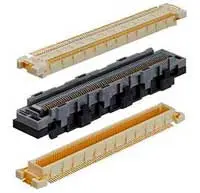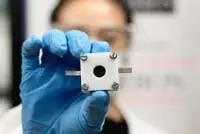Electronics News
Archive : 22 August 2017 год
 An SMT board-to-board connector developed by Hirose features a three piece floating contact system to simplify assembly and support data rates of up to 15Gbit/s.
An SMT board-to-board connector developed by Hirose features a three piece floating contact system to simplify assembly and support data rates of up to 15Gbit/s.
Designed for high-speed transmission applications that require multiple stacking connectors on the same PCB, the 0.5mm pitch FX10-3 series connector has a floating contact mechanism that is said to compensate for alignment errors up to ±0.3mm in the X and Y axes. This, says the company, allows for multiple connectors to be used in a mezzanine design reducing the stress on solder joints caused by misaligned connectors.
The three piece connector features a new design in which ground pins connect with ground bars. This design is said to lower crosstalk, thus improving the insertion-loss to crosstalk ratio and increasing transmission speed capability.
According to Bill Kysiak, product marketing manager for Hirose Electric USA: “The three piece design offers excellent signal integrity characteristics to deliver 15Gbit/s transmission required in high-speed applications.”
Available in 120, 144 and 168 positions, the FX10-3 series has a stacking height ranging from 8 to 13mm, with 1mm increments. Three types of interposers are offered; two have grounding options, with differential impedance values of 100Ω and 85Ω; while the other interposer does not provide grounding for all types of signals.
Designed to operate in temperatures ranging from -55 to 85°C, the connectors are rated at 50V AC and have a rated contact resistance of 130mΩ, and a minimum insulation resistance of 100MΩ at 100V DC.
Potential applications include base station transceivers, medical equipment, office imaging equipment, industrial machinery and servers.
Author
Graham Pitcher
Source: www.newelectronics.co.uk
 A family of high-performance PXI remote control and bus extension modules featuring PCI Express Gen 3 connectivity has been launched by National Instruments.
A family of high-performance PXI remote control and bus extension modules featuring PCI Express Gen 3 connectivity has been launched by National Instruments.
“As technologies converge into smarter devices under test, you increasingly need to build smarter test and measurement systems that leverage the latest processing and data movement capabilities in order to lower the cost of test or improve coverage,” said Luke Schreier, NI’s director of automated test marketing. “This new family of remote control modules augments our existing portfolio of PCI Express Gen 3 chassis and embedded controllers and more than doubles the throughput for multichassis systems.”
The PCIe-8398 host interface card is said to communicate over a fully transparent PCI Express Gen 3 x16 link to either the single-port PXIe-8398 or the dual-port PXIe-8399 remote control module, offering a sustained data throughput of up to 13.7Gbyte/s. According to the company, engineers can use the second port on the PXIe-8399 to daisy chain additional chassis, making it possible to directly interface multiple PXI Express chassis to a single host computer.
Meanwhile, the PXIe-8394 bus extension module supports peer-to-peer streaming at up to 6.8Gbyte/s between chassis-separated instruments. In addition, the PXIe-8394 allows high-throughput communication with peripherals that typically operate with substantial data sets.
Author
Graham Pitcher
Source: www.newelectronics.co.uk
 Finding ways to suppress certain chemical reactions could make compounds such as lithium iodide (LiI) work better in lithium-air (or lithium-oxygen) batteries, says a team at MIT.
Finding ways to suppress certain chemical reactions could make compounds such as lithium iodide (LiI) work better in lithium-air (or lithium-oxygen) batteries, says a team at MIT.
The LiI compound was seen as a possible solution to some of the lithium-air battery’s problems – including an inability to sustain many charging-discharging cycles – but conflicting findings had raised questions about the material’s usefulness for this task.
According to the team, lithium-air batteries would be very lightweight – which would be particularly useful in electric vehicles – but it has been limited in practice because of three issues: the need for high voltages for charging, low efficiency, and low cycle lifetimes, which result from instability in the battery’s oxygen electrode.
Researchers have proposed adding lithium iodide in the electrolyte as a way of addressing these problems. But published results have been contradictory, with some studies finding the LiI does improve the cycling life, while others are said to show that the presence of LiI leads to irreversible reactions and poor battery cycling.
“In this new study,” says MIT postdoc Michal Tulodziecki, “we explored in detail how lithium iodide affects the process, with and without water.”
The team looked at the role of LiI on lithium-air battery discharge. In the presence of both LiI and water, a different lithium compound, LiOH (lithium hydroxide) is said to have been produced, which interferes with the charging process. These observations show that finding ways to suppress these reactions could make compounds such as LiI work better.
This study could also point the way toward selecting a different compound to suppress unwanted chemical reactions at the electrode surface.
Author
Peggy Lee
Source: www.newelectronics.co.uk
 A solution to create rechargeable zinc-air batteries has been found according to researchers from the University of Sydney and Nanyang Technological University.
A solution to create rechargeable zinc-air batteries has been found according to researchers from the University of Sydney and Nanyang Technological University.
Zinc-air batteries are batteries powered by zinc metal and oxygen from the air. Due to the global abundance of zinc metal, the researchers claim these batteries are much cheaper to produce than lithium-ion batteries, but that they can also store more energy, are much safer and are more environmentally friendly.
While zinc-air batteries are currently used as an energy source in hearing aids and some film cameras and railway signal devices, their widespread use has been hindered by the fact that, up until now, recharging them has proved difficult. This is due to the lack of electrocatalysts that successfully reduce and generate oxygen during the discharging and charging of a battery.
To overcome this problem, the researchers have outlined a three-stage method to create bifunctional oxygen electrocatalysts for building rechargeable zinc-air batteries.
"Up until now, rechargeable zinc-air batteries have been made with expensive precious metal catalysts, such as platinum and iridium oxide. In contrast, our method produces a family of new high performance and low cost catalysts," said Sydney Professor Yuan Chen.
The catalysts are said to be produced through the simultaneous control of the composition, size and crystallinity of metal oxides of earth-abundant elements such as iron, cobalt and nickel.
According to the team, trials of zinc-air batteries developed with the new catalysts have demonstrated excellent rechargeability – including less than a 10% battery efficacy drop over 60 discharging/charging cycles of 120 hours.
Author
Peggy Lee
Source: www.newelectronics.co.uk

